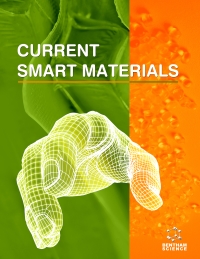- Home
- A-Z Publications
- Current Smart Materials
- Previous Issues
- Volume 4, Issue 1, 2019
Current Smart Materials - Volume 4, Issue 1, 2019
Volume 4, Issue 1, 2019
-
-
A Brief Review on E-skin and its Multifunctional Sensing Applications
More LessAuthors: Mariam T. Almansoori, Xuan Li and Lianxi ZhengElectronic skin (e-skin) is an artificial skin that mimics the sensing capabilities of human skin, which brings many potential applications in robotics, artificial intelligence, prosthetics, and health monitoring technologies. Many attempts associated with various mechanisms/approaches and materials/structures have been developed to match the e-skins to the particular functions of specific applications. Along the time, high s Read More
-
-
-
A Review on the Development of Dampers Utilizing Smart Magnetorheological Fluids
More LessAuthors: Jong-Seok Oh and Seung-Bok ChoiIt is generally known that MR fluid is a kind of designed materials whose rheological properties are controllable with the application of an external magnetic field. Based on these features, MR dampers have gained much attention of researchers owing to their salient properties such as controllable damping force and relatively fast response time. This article offers a recent review on the MR damper technology, particula Read More
-
-
-
Review of Structural Control Technologies Using Magnetorheological Elastomers
More LessAuthors: J. Yang, S.S. Sun, S.W. Zhang and W.H. LiIt is critically important to protect civil structures from unpredictable events, including earthquakes and strong winds, as well as maintaining their structural integrity and serviceability. To this end, considerable attention has been paid on the research and development of aseismic technology. This paper provides a literature review on the recent progress of Magnetorheological Elastomer (MRE) and the development and applica Read More
-
-
-
Polysaccharide-based Scaffolds for Bone Marrow Regeneration: Recent Work and Commercial Utility (Patent)
More LessAuthors: Rashmi Sharma, Pramod K. Sharma and Rishabha MalviyaBiochemical applications of polysaccharide are often demonstrated in various drug delivery systems and bone tissue engineering. Perhaps they are similar in biochemical properties with human components of the extracellular matrix, the body recognized them easily. In this manuscript, the polysaccharides, such as chitosan chitin, carrageenan, chondroitin sulfate,and cellulose used as scaffolds for bone regeneration, are dis Read More
-
-
-
Studies on Polyacrylate-Starch/Polyaniline Conducting Hydrogel
More LessAuthors: Reetu Prabhakar and Devendra KumarBackground: The superabsorbent polymers based conducting hydrogel such as polyaniline impregnated polyacrylate-starch hydrogel were synthesized via two -steps interpenetrating polymer network process. In the present work instead of using a synthetic polymer of acrylamide, a biodegradable polymer such as starch has been used with polyacrylate superabsorbent polymer. The main attempt of this work is to an Read More
-
-
-
Influence of Al, Ta Doped ZnO Seed Layer on the Structure, Morphology and Optical Properties of ZnO Nanorods
More LessAuthors: S. Mageswari and Balan PalanivelBackground: Zinc oxide (ZnO) is one of the most attractive II-VI semiconductor oxide material, because of its direct wide band gap (3.37 eV) and large binding energy (60 meV). Zinc oxide (ZnO) is a promising semiconductor due to its optimised optical properties. Among semiconductor nanostructures, the vertically aligned one-dimensional ZnO nanorods are very important for nano device application. Methods: Vertically Read More
-
-
-
Study on the Effect of Particle Size on Viscoelastic Properties of Magnetorheological Elastomers
More LessBackground: As an intelligent material, Magnetorheological Elastomer (MRE) has attracted extensive attention due to their excellent magnetic-induced properties. Aim: In addition to the matrix and interface, magnetic particle is the most critical factor in the magnetic properties of MRE. Particle size does not only affect on the magnetic properties of MRE, but also affects on interface and particle distribution. Therefore, stu Read More
-
-
-
Large-Scale Self-Assembly in Weakly-Flocculated Suspensions
More LessAuthors: Aleš Dakskobler and Matjaz ValantBackground: Studies on the formation of colloidal crystals in concentrated suspensions have mainly been based on dispersed suspensions with a repulsive inter-particle potential of hard or nearly hard spheres. The self-assembly in weakly-flocculated suspensions has still been unrealized. Here, we report on the formation of ordered structures in concentrated suspensions of nearly-hard spherical particles with weakly-attractive i Read More
-
-
-
The Repulsive Force Spectrum of Magnetorheological Fluids Based Tactile Devices Applicable to Robot Surgery
More LessAuthors: Yu-Jin Park, Ji-Young Yoon, Ye-Ho Lee and Seung-Bok ChoiObjective: This paper presents controllable force ranges of tactile devices made of smart Magnetorheological Fluids (MRF) and porous sponges (MR sponges in short). Methods: In order to identify the wide controllable range of the field-dependent repulsive force, three MR sponge samples with three different MR fluids are fabricated using polyurethane foam and cling film. Then, the repulsive forces of the samples are measured Read More
-
Volumes & issues
Most Read This Month
Article
content/journals/csm
Journal
10
5
false
en


